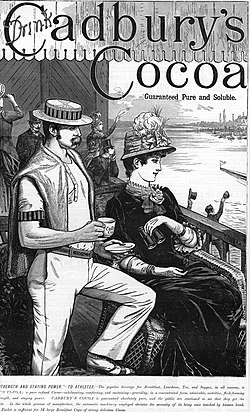The Rowers of Vanity Fair/Etherington-Smith RB
Etherington-Smith, Raymond Broadley
[edit | edit source]“Ethel” (Spy), August 5, 1908
[edit | edit source]
“Ethel” started on the race of this life in 1877 close by the Putney to Mortlake course, within a few days of the only dead-heat recorded in the annals of the Inter-University Boat Race, in 1877, and just fourteen years after his father had won the 1863 Grand Challenge Cup at Henley Regatta.
He was educated at Repton and Trinity College, Cambridge, where he amassed most of the titular distinctions indicated in the alphabet above.
Having won the Colquohoun Sculls, the Lowe Double Sculls, the University Pairs and Fours, and rowed twice Head of the River, he, in 1899, became President of the C.U.B.C., when he materially assisted in preventing Oxford from gaining her tenth successive victory in the Boat Race. In 1900 he was again victorious in a crew which has the proud distinction of having completed the course in a time which has never been beaten and only once equalled. He has been Captain of Leander on four occasions, viz., 1903, 1905, 1906, 1908, and has won the Grand Challenge three times and the Stewards’ Cup twice, besides being runner-up for the Diamond Sculls against F.S. Kelly in 1902. But Leander’s decisive victory over the Belgians the other day is, probably, the incident he is proudest of being associated with.
Not only as an athlete has he gained distinction; he is demonstrator of anatomy at St. Bartholomew’s Hospital, and has held all the residential appointments, including that of House Surgeon.
As a physician he has cured the evils which beset the under and over-trained oarsman, and has written cleverly on the subject. As a surgeon he has proved that apparently hopeless cases of fractured limbs can be set to rights under the manipulation of his deft fingers.
He likes himself best as an anatomical study for his pupils, and as a sculler, but he is at his best as an oarsman and friend.
As a motor cyclist he is a danger to himself and the public.
“The finest and handsomest young athlete I ever drew as an under-graduate,” wrote Leslie Ward, “was R.B. Etherington-Smith [(1877-1913)], known to his intimates as ‘Ethel.’”^ In fact Ethel took his first degree in 1899, nine years before Ward drew him for Vanity Fair to mark Leander’s victory in the 1908 London Olympics. At age thirty-one he captained the crew, apologizing to teammate Guy Nickalls who was ten years older: “I suppose they have asked me because I am about half-way down the line between yourself and Bucknall in age.”
Etherington-Smith died just after his thirty-sixth birthday from blood poisoning contracted while operating on a patient who had gangrene of the lung.
Staleness in Oarsmen
[edit | edit source]
“From close observation of many crews, I think staleness is a weakening of the will to win,” wrote H.G. Gold, “due principally to a crew suddenly realising the superiority of its opponents.”^ Etherington-Smith, in contrast, included staleness among the “evils which beset the under and over-trained oarsman,” and though mere alcohol may not thrill Cole Porter, for Ethel it was just the thing for the old ennui:
It is almost invariably found that at a certain period of training the men show signs of the hard work they have been undertaking by feeling “out of sorts.” They are depressed in spirits, feel tired and disinclined for exercise, lose their usual hearty appetite, and go down in weight.
. . . .
This so-called staleness, which, as I have already said, is but a stage on the high-road to racing condition, is a very curious phenomenon and somewhat difficult to satisfactorily account for. No doubt it is in great measure due to the hard physical work which has been accomplished, the body feeling the strain of the much-increased rate of metabolism necessitated thereby, but there is also a very marked nervous element.
. . . .
In the treatment of staleness champagne is of great value; indeed, when a man begins to show the signs of overwork a bottle of champagne for dinner in place of his ordinary liquor will often suffice to pull him round. As a rule, it is not wise to give champagne except under these circumstances, or to allow it on more than two evenings during training, but should any man remain below par for several days without any sign of improvement he may be given champagne diluted with mineral water as his regular beverage for lunch and dinner.
A week-end visit to the seaside is a splendid antidote to this kind of staleness; the bracing air and change of scene, even for so short a period, often work wonders in restoring the cheerful spirits and brisk demeanour which are so characteristic of a well-trained crew.^
